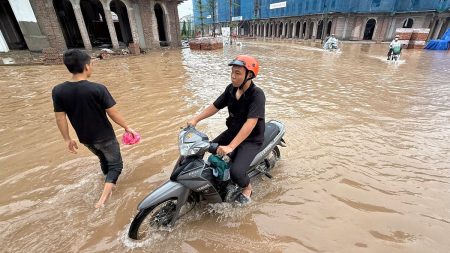Paragraph 1: The Fury of Cyclone Chido
Cyclone Chido, a powerful tropical storm with winds exceeding 220 km/h (137 mph), unleashed its fury on the French territory of Mayotte in the Indian Ocean on December 16, 2024. The cyclone, characterized by its intense winds, torrential rainfall, and storm surge, left a trail of devastation across the archipelago, impacting infrastructure, homes, and livelihoods. The prefect of Mayotte, the highest-ranking government official in the region, declared Chido the worst cyclone to strike the islands in nearly a century, highlighting the unprecedented nature of the storm’s intensity and the ensuing damage. As the cyclone moved through the region, authorities braced themselves for a potentially high death toll and initiated emergency response plans to address the unfolding crisis.
Paragraph 2: Mayotte’s Vulnerability and the Impact of Climate Change
Mayotte, a volcanic archipelago located in the Comoros archipelago between Mozambique and Madagascar, is particularly vulnerable to the impacts of tropical cyclones. Its location within the cyclone-prone Indian Ocean basin exposes it to the seasonal formation of these powerful storms. Climate change is believed to be exacerbating the intensity and frequency of tropical cyclones globally, increasing the risk to vulnerable island nations like Mayotte. Rising sea levels also compound the threat of storm surge, which can inundate low-lying coastal areas and cause significant damage. The unique geography of Mayotte, with its steep volcanic slopes and limited land area, further contributes to its susceptibility to landslides and flooding during extreme weather events.
Paragraph 3: The Unfolding Humanitarian Crisis
As Cyclone Chido’s destructive force subsided, the true extent of the devastation began to emerge, revealing a developing humanitarian crisis. The storm’s intense winds flattened homes, uprooted trees, and destroyed critical infrastructure, including power lines, communication networks, and transportation systems. The widespread damage hampered rescue and relief efforts, making it challenging to reach affected communities and assess the full scale of the disaster. The heavy rainfall triggered flash floods and landslides, further exacerbating the situation and posing significant risks to human life and property. Hospitals and medical facilities were overwhelmed with casualties, struggling to provide adequate care amidst the chaotic aftermath of the cyclone.
Paragraph 4: International Response and Aid Efforts
Following the immediate impact of Cyclone Chido, the French government mobilized resources and deployed emergency services to Mayotte to commence search and rescue operations and provide immediate relief to affected communities. International organizations, including the United Nations and various humanitarian aid agencies, responded to the crisis by providing essential supplies such as food, water, shelter, and medical assistance. Neighboring countries and international partners also pledged support and offered assistance in the recovery and reconstruction efforts. The international community recognized the urgent need for coordinated action to address the humanitarian crisis and mitigate the long-term consequences of the cyclone.
Paragraph 5: The Long Road to Recovery and Reconstruction
The recovery and reconstruction process in Mayotte following Cyclone Chido is expected to be a long and arduous undertaking. The extensive damage to infrastructure, housing, and essential services will require significant resources and expertise to rebuild. The restoration of basic services such as electricity, water, and sanitation is a top priority to ensure the well-being of the affected population and prevent the spread of diseases. The rebuilding of homes and communities will require careful planning and consideration of building codes and disaster resilience measures to mitigate the risks of future cyclones. The economic recovery of Mayotte will also necessitate sustained investment and support to revive businesses, agriculture, and tourism.
Paragraph 6: Building Resilience for the Future
The devastating impact of Cyclone Chido underscores the urgent need for proactive measures to enhance disaster preparedness and build resilience in Mayotte and other vulnerable regions. Strengthening early warning systems, improving building codes and land-use planning, and investing in disaster risk reduction initiatives are crucial steps to mitigate the impacts of future extreme weather events. Promoting community-based disaster preparedness programs can empower local communities to respond effectively to emergencies and protect themselves from harm. Addressing climate change and its contribution to the increasing intensity and frequency of tropical cyclones is paramount to safeguarding vulnerable island nations and ensuring their sustainable future. The experience of Cyclone Chido serves as a stark reminder of the importance of investing in resilience and preparedness to minimize the human and economic costs of future disasters.














